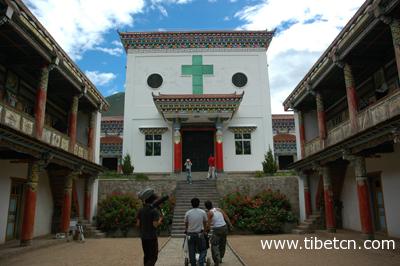One village with various religions
Yanjing is divided into two parts by the hilly topography, with Catholic Tibetans living on the upper side and Buddhist Naxis living in the lower village.
Every morning and evening, Catholics wearing traditional Tibetan clothes in Upper Yanjing gather in the Church with the only edition of a Bible in the Tibetan language in the world, and read it aloud after the priest.
Life for these Catholic villagers is colorful as they celebrate both traditional festivals and Catholic Christmas and Easter.
Life for the Buddhist Naxis in the lower part of the village is much like the Tibetans. It's been hundreds of years since these Naxi residents migrated into the village and they now speak the Tibetan language, eat Tibetan food, and celebrate Tibetan festivals.
Different religions? Yes. But, Catholics and Buddhists have never drifted far from each other in the village of Yanjing. On Christmas day, Buddhists Naxis invite themselves to the upper village and on the traditional sorcerer's dancing festival in Buddhism, Catholic Tibetans join the party in the lower village.
"I don't force my children to join Catholicism; they make their own choices," said Szalan.
Improved local life
In Yanjing, where traditional salt manufacturing has been going on for centuries, life once was tough for villagers as the great number of 3,249 salt fields were scattered on both shores of the Lantsang River. Villagers had to carry the salty water on their backs back home to isolate the salt. Due to a lack of agricultural land, local residents relied heavily on trading food for salt.
The village head, Gongchog Tashi, in Lower Yanjing recalled, even in the 1950s, he had to trade salt for food. Normally, he and his team of about 30 villagers and 100 horses carried salt via the ancient Tea Horse Road and ropeways made of bamboo. Even horses were tied to the ropeway to cross the Lantsang River.
Before the opening of the Yunnan-Tibet Highway the entire journey getting food back to the village took 20 days. According to Tashi, it only takes three days now. He says the ropeways have been abandoned since 1983 when a bridge was built across the Lantsang River.
By now, the 36,039 miles of Tibetan highway has replaced the mysterious Tea Horse Road and most of the local residents now mainly make a living from working in the cities.
In Yanjing, most families rely on motorcycles and it's not uncommon to come across Tibetan youth racing at full speed with sunglasses on. They pass by and leave behind only the sound of popular music playing from their motorcycles, which is the same commonly heard music listened to by Han youngsters.
In the Tibetan village, 98% of children attend school and the most beautiful building in the area is the Yanjing Middle school. In the school, students get free education, food, and lodging.
"Tibetan residents are impressively hospitable," said 25-year-old hiker Zhang Hong, recalling his six experiences hitchhiking on his way from Shangri-La to Yanjing.
"You lift your thumb, and these Tibetans will offer you a free ride with their motorcycles," said Zhang.


















